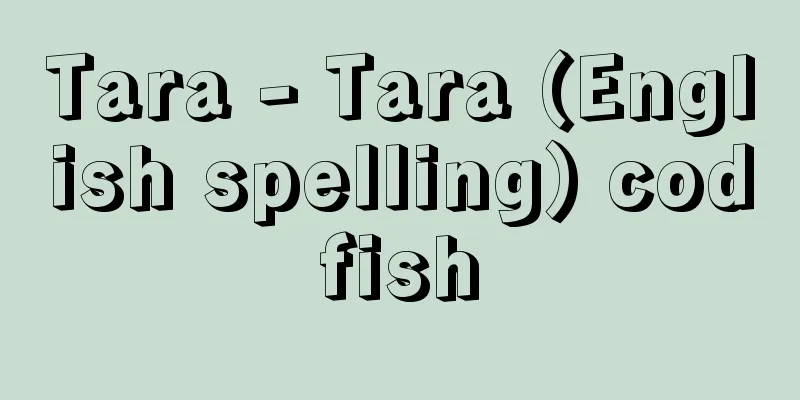Tara - Tara (English spelling) codfish

|
A general term for fishes belonging to the order Gadiformes and family Gadidae of the class Osteichthyes. There are 16 genera and about 31 species known worldwide. They are mainly distributed from the poles of the Northern Hemisphere to the temperate zones, and the most diverse is found in the Atlantic Ocean. Body size varies from about 15 centimeters for the silvery palat Gadiculus argenteus to over 2 meters for the Atlantic cod Gadus morhua . Most cods are typical marine fishes, but some species are resistant to low salinity, and some species, such as the codfish, can live in brackish waters. The only freshwater species is the burbot Lota lota . Fishes of the cod family generally have a slightly elongated body, thick in the front half and tapering toward the rear. The pelvic fins are pectoral and located forward of the base of the pectoral fins. The fin rays supporting each fin are all soft and have no spines. The scales are small and round, and the fish in this family have no airway connecting the swim bladder to the esophagus. The fish in this family are broadly divided into the subfamily Gadinae (cod, haddock) and the subfamily Lotinae (ling, burbot) (some researchers divide them into three or four subfamilies). The former have three dorsal fins, two anal fins, a straight or slightly forked trailing edge of the tail fin, and no oil globules in their eggs, while the latter have one or two dorsal fins, one anal fin, a round trailing edge of the tail fin, and oil globules in their eggs. There are only three species of cod found in Japan: Pacific cod, Alaska pollock, and cod lance, all of which belong to the subfamily Gadinae. The freshwater burrowing fish has an extremely wide distribution, with three known subspecies: L. l. lota , which is found from Europe to most of Siberia, the Korean Peninsula, and Sakhalin ; L. l. maculosa, which is found in eastern North America; and L. l. leptura, which is found from Alaska to Canada. [Tsuru Okamura and Kunio Amagaoka June 20, 2016] FisheriesGlobally, cod fishing is the third largest catch after herring and sardine fishing, and has been positioned as an important food resource. According to data from the Food and Agriculture Organization of the United Nations (FAO), catches fluctuated between 10 and 12 million tons (14-18% of the total fish catch) in the 1970s and 1980s, but fell to 9-10 million tons (6-11% of the total fish catch) between 1990 and 1999, and have been declining to 7-9 million tons between 2000 and 2008. Overfishing is thought to be the cause. The catch volumes of the major cod species from 2006 to 2012 varied slightly from year to year, but were as follows: Pacific cod ( Gadus macrocephalus ) 320,000 to 470,000 tonnes, Atlantic cod (G. morhua) 770,000 to 1.11 million tonnes, Alaska pollock ( Pollachius virens) 2.5 million to 3.27 million tonnes, pollock (Pollachius virens) 340,000 to 500,000 tonnes, hake ( Merluccius hubbsi and M. productus ) 980,000 to 1.1 million tonnes, and haddock (Melanogrammus aeglefinus) 320,000 to 430,000 tonnes. Meanwhile, Japan's cod fishery developed rapidly with its advance into the North Pacific fishing grounds, and according to documents from the Ministry of Agriculture, Forestry and Fisheries, it soared from 400,000 tons in the early 1960s to over 3 million tons in the early 1970s. However, as the country entered the 200-mile era in which each country claimed rights to marine resources within its own waters, negotiations with countries around the North Pacific (the Soviet Union, Canada, and the United States) regarding catch volumes became necessary, and catch volumes plummeted to 1.52 million to 1.7 million tons between 1978 and the early 1980s. They continued to decline after that, to about 370,000 tons in the late 1990s and about 280,000 tons in 2012. The breakdown by species is about 230,000 tons of Alaska pollock and about 50,000 tons of Pacific cod. Alaska pollock and Pacific cod are caught by trawling in the North Pacific and by medium-sized bottom trawl and longline fishing along the coast, with mother ship bottom trawl fishing being the largest in the Bering Sea region, and the fish are processed on board into frozen fish and frozen surimi. Komai is caught with coastal bottom trawl in autumn, but in winter, holes are drilled in the ice and the fish are caught with hand lines or fixed nets. They are made into prepared dishes or dried whole, and the sight of komai being dried is a famous feature of eastern Hokkaido. [Tsuru Okamura and Kunio Amagaoka June 20, 2016] Cod WarsThe northern North Atlantic, especially the area around Iceland, is one of the world's leading cod fishing grounds, and neighboring countries, including the United Kingdom, have relied on these waters for many of their marine resources. However, when full-scale fishing began in the 19th century, signs of overfishing gradually became more pronounced, and while initially recorded cod weighing 90 kilograms were caught, today, 18 kilograms is considered large, and the average catch has fallen to about 4.5 kilograms in fishing statistics. Therefore, in 1958, the Icelandic government, aiming to protect resources, declared the extension of its territorial waters from 4 nautical miles to 12 nautical miles, sparking a fierce dispute with the United Kingdom, which claimed vested interests there. The International Court of Justice ruled in favor of Iceland, but the decline in cod resources continued, so in 1972 the Icelandic government unilaterally declared a 50-nautical-mile exclusive fishing zone. Countries such as the UK ignored this and continued to operate within the 50-nautical-mile zone, which escalated into an international incident in May 1973 when an Icelandic gunboat opened fire on a British fishing boat. In response, the UK sent warships under the pretext of protecting its own fishing fleet, bringing the situation to the brink of war over fishery resources. In February 1975, Iceland expanded its exclusive fishing zone to 200 nautical miles, which again sparked armed conflict between the two countries. In June of the same year, the two countries agreed to a condition that the UK's catch be limited, and the dispute finally came to an end. This series of conflicts is known as the "cod wars." Currently, the situation remains calm. [Tsuru Okamura and Kunio Amagaoka June 20, 2016] FoodIn the seas near Japan, there are the large Pacific cod commonly known as "tara", the slightly smaller Alaska pollock, and the sakhalin cod, which is common in Alaska and Hokkaido. The flesh is very low in fat, white, and has a light taste. It is a fish that is often used abroad, especially in Europe. Because it has no strong flavor, it can be used in a wide range of dishes, such as minced meat, chirinabe (hot pot), ushiojiru (seaweed soup), simmered dishes, meunière, and fried dishes. Northern Japan has its own unique local cod dishes, including cod milt with herring roe (Hokkaido), cod ruibe (Hokkaido), cod dongara soup (Yamagata), cod jappa soup (Aomori), pickled cod roe (Niigata), boiled cod sticks (Niigata), and potato sticks (Kyoto). Dried products include stick cod, dried cod, and sukimi cod. Many of these are made from Alaska pollock. Alaska pollock is also caught in large quantities, and is used as a paste to make a variety of fish paste products. Tarako is the salted ovaries of Alaska pollock, and is also called momijiko or mintaiko. [Tomomi Kono and Midori Otaki] FolkloreAt Konourayama Shrine in Nikaho City, Akita Prefecture, on February 4th, the largest cod selected from the first catch is offered to the altar while flutes and drums are played. The Honcho Shokkan states that the name cod was chosen with the character for snow added to the character for fish because it is caught after the first snowfall, and it was especially prized in winter, when it was called "kandara" (cold cod). The expression "eating one's fill" comes from the voracious appetite of cod. This fish also matures quickly, has strong vitality, and does not bleed much when cut, so it was considered an auspicious fish among samurai families. [Kenichi Yano] [References] | | | Pollock | | | | |© Tadaaki Ohkata "> Major species of the cod family (from Japan) [specimen illustration] A small fish of the cod family. It lives in coastal waters and also enters brackish lakes. © Underwater Fort Enterprise, Isamu Soyama "> Porgy (ecology) ©Shogakukan "> Cod milt Cod ovaries. They are also called "true roe" as opposed to "milt" which is the testicular milt. ©Shogakukan "> Raw cod roe Salted pollock ovaries. Uncolored (top) and colored momiji (bottom) ©Shogakukan "> Alaska pollock roe Pollock ovaries salted in a seasoning liquid containing chili peppers ©Shogakukan "> Mentaiko Filleted cod ©Shogakukan "> Dried cod Source: Shogakukan Encyclopedia Nipponica About Encyclopedia Nipponica Information | Legend |
|
硬骨魚綱タラ目タラ科に属する魚類の総称。世界で16属約31種が知られている。おもに北半球の極付近から温帯域に分布し、大西洋でもっとも多様性に富んでいる。体のサイズは、最小ではシルバリーパラトGadiculus argenteusの約15センチメートル、最大ではタイセイヨウマダラGadus morhuaの2メートルを超えるものまでさまざまである。大部分のタラ科魚類は典型的な海水魚であるが、一部の種が低塩分濃度に対して抵抗性を有し、コマイなどは汽水域でも生息できる。そしてカワメンタイLota lotaが唯一の淡水種である。タラ科の魚は一般に体がやや延長し、前半部は太く、後方に向かって細くなる。腹びれは胸位で、胸びれ基底より前方に位置する。各ひれを支える鰭条(きじょう)はすべて軟条で棘条(きょくじょう)はない。鱗(うろこ)は円鱗(えんりん)で小さく、うきぶくろと食道をつなぐ気道がないなどの特徴をもつ。本科の魚はタラ亜科Gadinae(コッドcod、ハドックhaddock)とカワメンタイ亜科Lotinae(リングling、バルボットburbot)に大別される(3亜科または4亜科に分ける研究者もいる)。前者では背びれが3基、臀(しり)びれが2基で、尾びれの後縁がまっすぐか、またはわずかに二叉(にさ)し、卵に油球がないのに対し、後者では背びれは1基または2基、臀びれは1基で、尾びれの後縁は丸く、卵に油球がある。日本産のタラ類はマダラ、スケトウダラ、コマイの3種だけで、いずれもタラ亜科に属する。淡水産のカワメンタイの分布はきわめて広く、ヨーロッパからシベリアの大部分、朝鮮半島および樺太(からふと)(サハリン)に分布するL. l. lota、北アメリカ東部に分布するL. l. maculosaおよびアラスカからカナダに分布するL. l. lepturaの3亜種が知られている。 [岡村 收・尼岡邦夫 2016年6月20日] 漁業世界的にみてタラ漁業は、ニシン、イワシ漁業に次いで漁獲量が多く、重要食糧資源として位置づけられてきた。国連食糧農業機関(FAO)の資料によると、漁獲量は1970年~1980年代は1000万~1200万トン台(魚類総漁獲量の14~18%)で推移していたが、1990年~1999年は900万~1000万トン台(魚類総漁獲量の6~11%)に減少し、2000年~2008年では700万~900万トンと減少傾向にある。過剰な漁獲が原因であると考えられている。2006年~2012年のおもなタラの漁獲量は多少の年変動があるが、太平洋産マダラGadus macrocephalusが32万~47万トン、大西洋産マダラ類G. morhuaが77万~111万トン、スケトウダラでは250万~327万トン、ポラックPollachius virensが34万~50万トン、ヘイク類(Merluccius hubbsiとM. productus)は98万~110万トン、ハドックMelanogrammus aeglefinusが32万~43万トンである。 一方、日本のタラ漁業は北洋漁場への進出に伴って急速に発展し、農林水産省の資料によると、1960年代初期の40万トンから1970年代前半に300万トン余りへと急増した。しかし、世界各国が自国水域内の海洋資源への権利を主張する200海里時代に入るとともに、北太平洋周辺諸国(ソ連、カナダ、アメリカ)との漁獲量に関する協議が必要となり、漁獲量は1978年~1980年代前半には152万~170万トンに激減した。その後も1990年代後半には約37万トン、2012年には約28万トンと減少している。魚種別内訳はスケトウダラ約23万トン、マダラ約5万トンである。スケトウダラとマダラは北洋ではトロール、沿岸では中型底引網、延縄(はえなわ)などで漁獲され、とくにベーリング海域での母船式底引網漁業はもっとも規模が大きく、船上で冷凍魚や冷凍すり身に加工される。コマイは秋季には沿岸底引網で漁獲されるが、冬季には氷に穴をあけ、手釣りや定置網でとる。総菜や丸干しにされ、コマイ干しの風景は北海道東部の風物詩として有名である。 [岡村 收・尼岡邦夫 2016年6月20日] タラ戦争北大西洋北部、とくにアイスランド周辺は世界有数のタラ漁場であり、イギリスをはじめとする周辺諸国は、この海域に水産資源の多くを依存してきた。しかし、19世紀に本格的漁業が開始されると乱獲の兆しがしだいに強まり、当初は90キログラムのマダラが記録されたが、現在では18キログラムもあれば大きいほうで、漁獲統計上の平均値は約4.5キログラムまで低落している。したがって、資源保護を目ざしたアイスランド政府は、1958年に4海里から12海里への領海拡張宣言を行い、既得権を主張するイギリスとの間に激しい争いを引き起こした。 国際司法裁判の結果はアイスランドの勝訴となったが、その後もタラ資源の減少が続いたため、1972年にアイスランド政府は漁業専管水域50海里を一方的に宣言した。これを無視したイギリスなどの諸国は、50海里内に侵入して操業を強行したため、ついに1973年5月アイスランド砲艦がイギリス漁船に発砲するという国際事件へと発展した。これに対してイギリスも自国の漁船団を保護するという名目で軍艦を派遣し、水産資源をめぐる戦争直前の事態となった。さらに1975年2月、アイスランドが漁業専管水域を200海里に拡大したことで、再度両国間で武力衝突が起こった。同年6月、イギリスの漁獲量を制限するという条件に両国が合意したことにより、ようやくこの争いが終結した。この一連の紛争を「タラ戦争」という。現在では平静な状態を保っている。 [岡村 收・尼岡邦夫 2016年6月20日] 食品日本近海には一般にタラとよばれる大形のマダラ、やや小形のスケトウダラ、アラスカ、北海道に多いコマイがいる。身には脂肪がたいへん少なく、白身で淡泊な味である。ヨーロッパなど外国でもよく利用される魚である。くせがないので、そぼろ、ちり鍋(なべ)、潮汁(うしおじる)、煮つけ、ムニエル、フライなど広範囲に使える。北日本には特有のタラの郷土料理があり、おもなものにタラ白子(しらこ)の数の子和(あ)え(北海道)、タラのルイベ(北海道)、タラのどんがら汁(山形)、タラのじゃっぱ汁(青森)、タラの子漬け(新潟)、棒だら煮(新潟)、いも棒(京都)などがある。 乾燥品に棒だら、干だら、すき身だらなどがある。これらの多くはスケトウダラが原料として使われる。またスケトウダラは大量漁獲魚であり、すり身として各種の練り製品の原料にされる。たらこはスケトウダラの卵巣の塩漬けで、紅葉子(もみじこ)、めんたい子(みんたい子)ともよばれる。 [河野友美・大滝 緑] 民俗秋田県にかほ市の金浦山(このうらやま)神社では、2月4日の「掛魚(かけよ)まつり(たらまつり)」に、初漁のなかから選んだ最大のタラを笛や太鼓ではやしながら神前に供える。『本朝食鑑(ほんちょうしょっかん)』には、タラの名は、初雪のあとにとれるため、魚偏に雪を配すとあり、とくに「寒鱈(かんだら)」といって冬季に珍重された。「鱈腹(たらふく)食べる」というのは、タラの貪食(どんしょく)性に由来する。また、早く成魚になって生命力が強いこの魚は、切ってもあまり血が出ないことから、武家で縁起のよい魚とされた。 [矢野憲一] [参照項目] | | | | | | | |©大片忠明"> タラ科のおもな種類(日本産)〔標本画〕 タラ科の小形魚。沿岸水域に生息し、汽水湖にも出入りする©水中フォート・エンタープライズ 楚山いさむ"> コマイ(生態) ©Shogakukan"> マダラの白子 マダラの卵巣。精巣の白子に対し、真子ともいう©Shogakukan"> マダラの生たらこ スケトウダラの卵巣の塩漬け。無着色のもの(上)と着色した紅葉子(下)©Shogakukan"> スケトウダラのたらこ スケトウダラの卵巣を、トウガラシを加えた調味液で塩漬けしたもの©Shogakukan"> めんたい子 マダラの開きだら©Shogakukan"> 干だら 出典 小学館 日本大百科全書(ニッポニカ)日本大百科全書(ニッポニカ)について 情報 | 凡例 |
Recommend
Neagari [town] - Neagari
An old town in Nomi County in southern Ishikawa Pr...
Mangyshlak
...Due to the development of heavy industry, meta...
Overthrowing the ruling class
This word means that a person of lower rank surpa...
Al-Aqsamiran
…He was a scholar well versed in Greek, and wrote...
Makassar
The name of the city means "cape covered wit...
Fisheries Agency - Suisancho
It is one of the external bureaus of the Ministry...
History of Tianze - Shitentaku
A powerful man in Hebei who cooperated with the M...
Nishisenboku [town] - Nishisenboku
This old town in Senboku-gun occupies the middle r...
Eel pond - Eel pond
A crater lake at the southeastern end of the Sats...
Deep Sea - Okunoumi
…An inlet further inland from Ishinomaki Bay in e...
Belt fittings - Obikanag
A decorative metal fitting made of gold, silver, ...
American New Cinema
...This expression was first used in the American...
Eragrostis multicaulis (English spelling)
…[Tetsuo Koyama]. … *Some of the terminology that...
Husayn
King of Hijaz, an area in the northwest of the Ara...
open-cast mining
…a colloquial term for surface mining, or open-pi...









